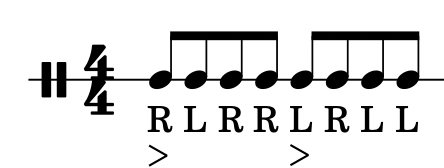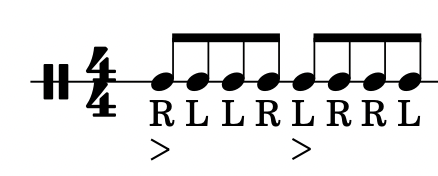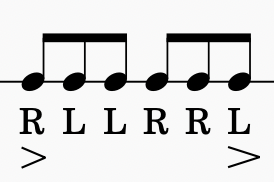Not everyone has hours each day to sit behind a drum kit, and that’s okay. Life gets busy with work, family, and everything in between. But here’s the good news: even just 10 minutes of focused drumming a day can lead to real progress. Consistent daily practice is far more effective than an hour-long session once every couple of weeks. If you’re juggling a busy schedule, this post is packed with smart drumming tips to help you stay sharp, motivated, and improve, even with limited time.
1. Anchor Your Drum Practice to Daily Habits
Let’s be honest, most of us aren’t going to block out “drum practice” in our calendars like a corporate meeting. But that doesn’t mean you can’t plan ahead. The trick is to build a drumming habit that fits your real life, not the ideal one.
Think about when you reliably have 10 free minutes and, more importantly, decide what you’ll practice during that time. You don’t want to finally carve out a quiet moment and then waste it deciding what to work on.
One of the easiest and most effective methods is habit stacking. Instead of forcing practice into your schedule, link it to something you already do every day. For example:
- A 5-minute pad session after your morning coffee
- Some rudiments right after putting the kids to bed
- A quick warm-down after your evening bike ride
This way, daily drumming practice becomes part of your natural rhythm. And remember, it’s not about perfection. It’s about consistency. Miss a day? No big deal. Just pick it up again tomorrow.
2. Master the 10-Minute Drum Practice
You’ve only got 10 minutes, make them count. That quick session should be focused drumming, not just noodling around (as fun as that is). Freestyle playing has its place; it’s great for creativity and stress relief, but your practice time should target specific skills you want to improve.
A great way to get more out of those minutes is to use a metronome. Honestly, it’s one of the best tools a drummer can have. Music is all about organizing time, and a metronome helps you internalize timing and develop steady, consistent speed. Check out this video by Benny Greb https://www.youtube.com/watch?v=eAihk6H6oHY It completely changed how I use a metronome. It’s not just about clicking on the beat; there are smarter ways to use it that really sharpen your timing.
Before you sit down to play, build out your 10-minute drum routine. For example, if you’re working on speed, spend most of that time on single strokes or double strokes, increasing your BPM slightly each session. The key is to go slow enough to play cleanly, no racing ahead and piling up mistakes. Good form always beats fast form.
You can also use your time to drill rudiments. Pick one or two and go deep. Or, if you’re laser-focused on a specific challenge like learning a tricky intro or song part, devote the full session to that. Personally, I’m a big Tool fan. This week, while visiting family and working remotely, I’ve been using my practice time to nail the intro to Ticks & Leeches. It’s been super rewarding (and yeah, I sneak in some fun grooves afterward too).
Here are a few bonus tips that will make your short sessions even more powerful:
- Mind your dynamics: Make sure your stick heights are even. When practicing accents, over-exaggerate them at slower speeds and keep the ghost notes whisper-quiet. That discipline carries over into faster, more expressive playing.
- Count out loud: Don’t be shy. Whether you’re counting “1 e & a, 2 e & a…” or using made-up words, vocalizing rhythms sharpens your timing and focus. If you can talk and play at the same time, you’ve probably mastered the pattern. That’s a great benchmark to aim for.
- Practice in front of a mirror or just a reflective door (like the balcony door). If you are like me and do not really like recording yourself all the time or do not have space on your phone ever practicing in front of a mirror will reveal your technique dynamics and help you asses yourself.
3. Practice Drumming Off the Kit
You don’t need to be behind a drum kit to get better. Some of the most effective drumming practice happens away from the kit during daily downtime, while multitasking, or even just chilling on the couch.
Off-kit practice can mean tapping out rudiments on your thighs, working on stick control with a pillow, or simply watching drum technique videos to absorb new ideas. For example, I often practice double strokes on a couch pillow while watching Netflix. The lack of bounce makes it a killer workout for your hands, and it’s been surprisingly effective.
You can also air-drum grooves during your commute or on work breaks. Just keep it low-key, I’ve had my fair share of awkward glances on the bus when I got too into a fill! A quiet tap on your lap or a subtle finger exercise is often all you need to keep that muscle memory going.
And don’t underestimate the power of watching playthroughs, rudiment breakdowns, or drum lessons while doing chores like folding laundry or cooking. These seemingly passive moments add up and help you stay connected to your drumming even when life pulls you away from the sticks.
Whether you’re a parent catching five minutes between bedtime stories or someone squeezing in practice during lunch breaks, off-kit drumming is a powerful way to stay sharp and keep improving, no drum throne required.
4. Seek Feedback from a Drum Teacher
If you’re just starting, one of the smartest moves you can make is to get feedback from a professional drum teacher. I know finding time, committing to lessons, and paying for them can be tough. But trust me, even a few sessions with the right teacher can make a massive difference in your technique and progress.
Why does it matter so much? Because learning proper drumming technique early on helps you avoid injury, develop speed, and play with control and ease. Technique is everything, especially if you want faster hands, better endurance, and more relaxed playing.
You might see big-name drummers in interviews saying they don’t practice anymore. Don’t let that fool you. Most of the professional drummers I’ve met, even those who tour and record full-time, still practice way more than you’d think. And those who “don’t practice” anymore? It’s usually because they have already put in years of intense, focused practice to get to a level where they can play anything on the spot.
Whether it’s in person or through an online platform, having a qualified drum coach watch you play and offer tips is one of the fastest ways to grow. Even occasional feedback can correct habits early and keep you on the right path.
5. Make Drumming a Family Thing
Got a toddler running around? Turn drum practice into family fun. Hand them a pair of sticks and let them tap along on a pad, or set up a mini jam session with pots, buckets, or toy drums. You’d be surprised how much joy and creativity come out of these little moments.
Drumming with your kids isn’t just cute, it’s a great way to bond, share your passion, and even build a few core memories. And who knows? You might be raising your future bandmate. Just make sure it stays lighthearted. The goal is to have fun together, never force it, or it can backfire and turn them off drumming altogether.
Whether it’s five minutes of shared chaos or a full family jam session, this kind of play-based music exposure keeps your passion alive while showing your little one what fun creativity looks like.
6. Talk Drums with Other People
One of the most underrated ways to grow as a drummer is simple: talk drums. Find others, friends, fellow hobbyists, or online communities and start sharing ideas. Whether they’re beginners or seasoned pros, talking shop with other drummers always brings new insights.
You can join online drum forums, Reddit threads, or local music groups. Even a casual chat with another drummer might reveal a technique, exercise, or practice tool you haven’t thought of. We all get stuck in our own routines sometimes, and talking with others can help break through plateaus and reignite inspiration.
Don’t underestimate the value of being part of a drumming community, even if it’s just a chat group on your phone. Sometimes, one simple tip or shared video can completely shift your approach.
7. Invest in the Right Tools (Without Breaking the Bank)
When I say invest in the right tools for drumming, I don’t mean running out and buying the most expensive drum kit you can find. Especially if you’re just starting or coming back to drums after a break, it’s smarter to match your gear to your real-life situation.
If you’re in a small apartment with thin walls and sleeping kids, a quiet practice pad and a pair of sticks are more than enough to get started. Want a full kit experience without the noise? An electronic drum set might be perfect. And hey, if you live in a mansion with no neighbors, go ahead and get that Terry Bozzio-sized kit and live the dream. (If you haven’t seen it, here’s the Drum Channel video of Bozzio playing his monster setup. Absolute madness!)
One of my personal favorite low-cost upgrades? Rubber tips for drumsticks. They turn just about any surface into a decent practice pad and give your sticks a great bounce. They’re cheap, portable, and surprisingly effective. Here’s a link to the ones I use https://www.thomann.de/intl/tama_tcp10d_silent_tips.htm. Highly recommended if you want to keep your hands moving without making a racket.
The bottom line: You don’t need a fancy setup to get better at drums. Just find the gear that fits your space, budget, and routine. You can use the music shop in the link before it’s one of the biggest ones, and they have a myriad of drum gear. Drumming on a budget can still take you a long way; it’s all about consistency, not cost.
Conclusion: Yes, You Can Drum, Even with a Busy Life
So, to wrap it all up: if you’re busy but still want to play drums, it’s absolutely possible, and deeply rewarding. The secret isn’t in having endless time or expensive gear. It’s about planning your routine, sticking with it consistently, and making the most of your 10 minutes a day.
You don’t need a full kit to start. A pair of sticks, a practice pad (or even a pillow), and a clear goal are enough to build real skills. Whether you’re a beginner, a returning drummer, or just someone trying to stay sharp, small, focused practice sessions can add up to big results.
I’ll be sharing more detailed practice routines, drumming tips for beginners, and personal insights in future posts. If this helped you or inspired you to get started, let me know!
And now, as promised, here’s a simple 10-minute drum practice routine designed for beginners. These exercises will help build your foundation and get your hands moving with purpose. I’ve added short comments for each one to help guide your practice.
10-Minute Beginner Drum Routine (Warm-Up Focus)
Here’s a simple beginner drum routine you can do daily, perfect for developing control, speed, and timing, even if you’re short on time. And yes, even advanced drummers go back to these fundamentals. Don’t underestimate the power of the basics.
Start with your metronome set to 40–50 BPM. The goal isn’t to play fast, it’s to play clean and relaxed. Once you’re comfortable, increase the tempo by 1–2 BPM per day. Small steps lead to solid gains.
Spend about 2 minutes on each exercise below. That’s your full 10-minute warm-up. If you notice mistakes or tension creeping in, don’t push through; just dial the tempo back down a notch and rebuild cleanly.
Also, keep dynamics in mind. Try to maintain even stick heights, and when practicing accents, really exaggerate them at slow speeds. Make your grace notes super quiet, this contrast helps you sound more expressive when things speed up.
🎧 Tip: Count out loud while you play, something like “1 e and a, 2 e and a…” for each bar. It locks in your timing and helps internalize the rhythm.
🧠 Want to go deeper? Check out Drumeo’s full list of 40 essential drum rudiments. There are video tutorials for each one, so it’s worth having a look.
https://www.drumeo.com/beat/rudiments/?srsltid=AfmBOopIFprgpIozFB1ztqlV1Gvdq4GWcgdFQS0L6ThYMu_yYsj_A3A-
This warm-up can be done on a pad or even a pillow (my go-to during Netflix downtime). I haven’t added more advanced exercises here, but I might in a future post if folks find this helpful. I’m no pro teacher, just sharing what’s worked for me.
🥁 The Routine:
1. Single-Stroke Roll
Alternate R-L-R-L… Simple, but it’s the backbone of everything. Aim for smooth, even strokes.

2. Double-Stroke Roll
R-R-L-L… This one sounds amazing when fast, but focus on clean rebounds first.

3. Paradiddle (Standard)
R-L-R-R, L-R-L-L… Probably the most famous rudiment, and super useful around the kit.

4. Paradiddle (Variation 2)
A twist on the original. Great for brain-hand coordination and breaking habits. (My favorite version)

5. Six-Stroke Roll
R-L-L R-R-L… A little more complex, but a great way to start mixing rudiments and preparing for musical application. Take care, these are six strokes, so counting could be a bit trickier.

Use this routine daily as your go-to 10-minute drumming warm-up, and you’ll start noticing stronger hands, better control, and improved timing, even if you’re just squeezing in practice on the couch after a long day.
Has this helped? Do you have any tips to share? Is there anything you would like to see in a future blog post that I may have missed?
